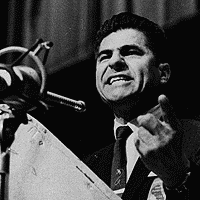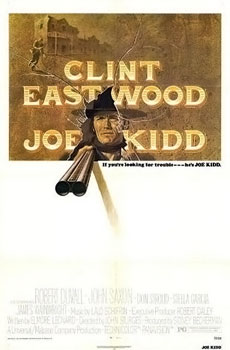
Tierra Amarilla is a census-designated place in and the county seat of Rio Arriba County, New Mexico, United States.

Rio Arriba County is a county in the U.S. state of New Mexico. As of the 2020 census, the population was 40,363. Its county seat is Tierra Amarilla. Its northern border is the Colorado state line.

Reies López Tijerina, was an activist who led a struggle in the 1960s and 1970s to restore New Mexican land grants to the descendants of their Spanish colonial and Mexican owners. As a vocal spokesman for the rights of Hispanos and Mexican Americans, he became a major figure of the early Chicano Movement and founded the Alianza Federal de Mercedes. As an activist, he worked in community education and organization, media relations, and land reclamations. He became famous and infamous internationally for his 1967 armed raid on the Tierra Amarilla courthouse located on the Tierra Amarilla Land Grant whose lands, originally designated for Hispanic settlers, had largely been acquired by Anglo ranchers and land developers.

Jicarilla Apache, one of several loosely organized autonomous bands of the Eastern Apache, refers to the members of the Jicarilla Apache Nation currently living in New Mexico and speaking a Southern Athabaskan language. The term jicarilla comes from Mexican Spanish meaning "little basket", referring to the small sealed baskets they used as drinking vessels. To neighboring Apache bands, such as the Mescalero and Lipan, they were known as Kinya-Inde.

Thomas Benton Catron was an American politician and lawyer who was influential in the establishment of the U.S. state of New Mexico, and served as one of its first United States Senators. Catron has defenders but enemies have described him as a "greedy land grabber and ruthless politico."

Mutualistas were community-based mutual aid societies created by Mexican immigrants in the late 19th century United States. According to media analyst Charles M. Tatum, mutualistas
"provided most immigrants with a connection to their mother country and served to bring them together to meet their survival needs in a new and alien country. Cultural activities, education, health care, insurance coverage, legal protection and advocacy before police and immigration authorities, and anti-defamation activities were the main functions of these associations.

Chicanismo emerged as the cultural consciousness behind the Chicano Movement. The central aspect of Chicanismo is the identification of Chicanos with their Indigenous American roots to create an affinity with the notion that they are native to the land rather than immigrants. Chicanismo brought a new sense of nationalism for Chicanos that extended the notion of family to all Chicano people. Barrios, or working-class neighborhoods, became the cultural hubs for the people. It created a symbolic connection to the ancestral ties of Mesoamerica and the Nahuatl language through the situating of Aztlán, the ancestral home of the Aztecs, in the southwestern United States. Chicanismo also rejected Americanization and assimilation as a form of cultural destruction of the Chicano people, fostering notions of Brown Pride. Xicanisma has been referred to as an extension of Chicanismo.
El Grito del Norte was a bilingual newspaper based in Española, New Mexico, co-founded by the activist Elizabeth "Betita" Martinez and the attorney Beverly Axelrod in 1968. Before this, Martínez had worked with social issues such as the black movement and the Student Nonviolent Coordinating Committee while Axelrod had been involved in the first production of The Black Panther. The tabloid was originally the publication of the Reies Tijerina's Alianza Federal de Mercedes, an organization dedicated to recovering the lands of dispossessed Hispanos, whom Axelrod represented as a lawyer. It expanded to provide coverage of the Chicano Movement in urban areas, workers' struggles and Latino political prisoners, as well as other Leftist causes. The paper often advocated for the advancement of such minority groups as well as the Black and Native American communities.

Carson National Forest is a national forest in northern New Mexico, United States. It encompasses 6,070 square kilometers and is administered by the United States Forest Service. The Forest Service's "mixed use" policy allows for its use for recreation, grazing, and resource extraction.

Joe Kidd is a 1972 American Western film starring Clint Eastwood and Robert Duvall, written by Elmore Leonard and directed by John Sturges.

The Albuquerque–Santa Fe–Las Vegas combined statistical area is made up of eight counties in north central New Mexico. The combined statistical area consists of the Albuquerque and Santa Fe metropolitan statistical areas, and the Las Vegas, Los Alamos, and Española micropolitan statistical areas. The 2013 delineations included the Grants micropolitan statistical area, but it was removed in the 2018 revisions. As of the 2020 census, the CSA had a population of 1,162,523. Roughly 56% of New Mexico's residents live in this area. Prior to the 2013 redefinitions, the CSA consisted only of the Santa Fe metropolitan statistical area and the Española micropolitan statistical area. The total land area of the Albuquerque–Santa Fe–Las Vegas combined statistical area in the 2013 definition is 26,421 sq mi (68,430 km2).
Land grants in New Mexico and Colorado were awarded to individuals and communities by the Spanish and Mexican governments to encourage settlement and expansion of the Territorio de Nuevo Mexico, which included southern Colorado. Land grants by the Spanish and Mexicans between 1692 and 1846 numbered 291 in New Mexico, four partly in New Mexico and partly in Colorado, and three in Colorado. The land area of grants totaled tens of thousands of square miles. "The two major types of land grants were private grants made to individuals, and communal grants made to groups of people for the purpose of establishing settlements. Communal land grants were also made to Pueblos for the lands they inhabited." The majority of the land area within grants was designated as common land for residents. Common land was mostly used for grazing cattle and sheep. Smaller acreages within the grants were devoted to irrigation agriculture and home sites. The principal objectives of the land grants were to encourage the foundation of new communities and to expand the settled area on the frontiers of New Mexico for defense from Indian raids.

The Tierra Amarilla Land Grant in northern New Mexico and southern Colorado consists of 594,516 acres (2,405.92 km2) of mountainous land. It was awarded by the government of New Mexico to Manuel Martinez and his offspring in 1832. The grant was settled by Hispanics in the 1860s. Settlers were given small plots, but most of the land in the grant area was designated as common land for the use of all the original settlers and their descendants on the grant. After its conquest of New Mexico in 1846, the United States government upheld the validity of the grant, but subsequent actions by the U.S. did not protect the right to access common lands by the settlers. Politician and land speculator Thomas Catron, a member of the Santa Fe Ring, acquired nearly all the land by 1883 but later sold it to development companies. Access to the common lands of the grant by the Hispanic settlers and their descendants gradually disappeared as the common land became owned by mostly Anglo ranchers, development companies, and speculators.
Juan Valdez was a land grant activist who fired the first shot during a 1967 New Mexico courthouse raid that grabbed international attention & helped spark the Chicano Movement.
The following is a timeline of Latino civil rights in the United States.
The People's Constitutional Party was a political party active in the U.S. state of New Mexico during the late 1960s and early 1970s.
State Road 162 (NM 162) is a 2.6-mile-long (4.2 km) state highway in the US state of New Mexico. Entirely within Rio Arriba County, NM 162's southern terminus is at U.S. Route 84 (US 84) south of Tierra Amarilla and the northern terminus is at US 64 and US 84 north of Tierra Amarilla. It is a paved, two-lane road for its entire length.

Leonard Emlyn Davies is an American lawyer, civil rights activist, writer, and painter whose early work defending migrant farm workers and the Black Panther Party resulted in his participation in "The Trial: The City and County of Denver vs. Lauren R. Watson," the first criminal trial to be filmed in its entirety in the United States.

A Mexican American is a resident of the United States who is of Mexican descent. Mexican American-related topics include the following:
Enrique Lamadrid is an American historian in the US state of New Mexico, known for his studies of Chicano, Mexican American, and Hispano culture. He is Professor Emeritus for the Department of Spanish and Portuguese at University of New Mexico. He has worked for the Smithsonian Institution, Museum of New Mexico, and the National Hispanic Cultural Center. He has written books in both English and Spanish.











